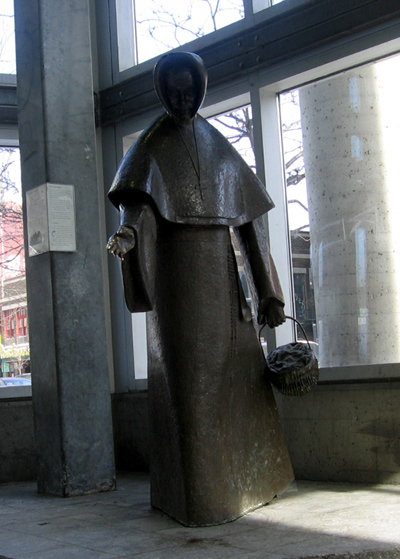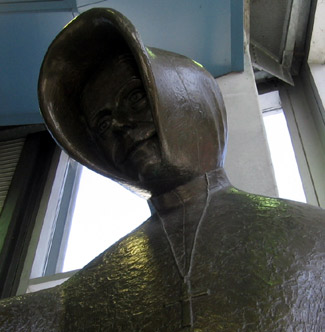
 Mère Émilie Gamelin, 1999
Mère Émilie Gamelin, 1999
Bronze
Height 1,9m
Location: Berri-UQAM station, Sainte-Catherine kiosk

Detail
One of the newest works of art in the metro, this human and welcoming statue was a gift from the Sisters of Providence, Mother Émilie's order, and was inaugurated on 25 May 2000 commemorating both the 200th anniversary of her birth and the renovation of the rue Sainte-Catherine kiosk, located in the Place Émilie-Gamelin where the shelter she founded once stood.
It is one of only two figurative statues in the metro (with Joseph-Arthur Vincent's Jacques Cartier at Place-Saint-Henri) and the only one made for the metro.
Located on a low dais, the statue shows Mother Émilie stretching a helping hand to the poor. Passers-by occasionally shake her hand, resulting in a slight wearing of the bronze; indeed, the statue has become a minor focus of religious devotion, with the faithful occasionally handing out pamphlets about Mother Émilie near the statue.
| MÈRE ÉMILIE GAMELIN Surnommée « La Providence des pauvres » et « l'Ange des prisonniers », madame Émilie Tavernier-Gamelin (1800-1851) deviendra mère Gamelin et l'une des femmes les plus remarquables de l'histoire de Montréal. |
MOTHER ÉMILIE GAMELIN Nicknamed "the providence of the poor" and "the prisoners' angel," Émilie Tavernier-Gamelin (1800-1851), later Mother Gamelin, was one of the most remarkable women in the history of Montreal. |
| Femme d'action et de compassion, travailleuse infatigable, elle fonde en 1843 la Communauté des soeurs de la Providence. Mettant toutes ses ressources au service des plus démunis de la société, elle sera particulièrement active dans plusieurs refuges qu'elle ouvre sur la rue Sainte-Catherine. C'est d'ailleurs à l'angle de la rue Saint-Hubert qu'est construit en 1843 l'Asile de la Providence, à l'endroit même où est située la place qui porte maintenant son nom. | A woman of action and compassion and a tireless worker, in 1843 she founded the Order of the Sisters of Providence. Putting all her substance into service for the poorest members of society, she was especially active in the shelters she opened on rue Sainte-Catherine. In 1843 the Asylum of Providence was built at the corner of rue Saint-Hubert, now within the square that bears her name. |
| Parmi les nombreuses initiatives de la mère Gamelin, « l'Oeuvre de la Soupe » avait ici porte ouverte. De 1843 à 1962, soit pendant 120 ans, des millions de bols de soupe seront distribués aux affamés et aux sans-travail à l'Asile de la Providence. | Among Mother Émilie's many initiatives, "the work of the soup" was located here. Over almost 120 years from 1843 to 1962, millions of bowls of soup were served to the hungry and unemployed at the Asylum of Providence. |
| LE MONUMENT Vêtue du costume de sa communauté, mère Emilie Gamelin est représentée en pleine action, portant à son bras un panier de vivres destiné à soulager la faim et la misère des oubliés de son temps. |
THE MONUMENT Dressed in the habit of her order, Mother Émilie Gamelin is represented in full action, bringing a basket of food to ease the hunger and misery of the forgotten people of her times. |
| Le mouvement accentué de sa démarche rappelle son grand dynamisme et sa générosité envers autrui. Mère Gamelin n'est pas représentée sur un socle élevé, elle se trouve plutôt parmi les passants. Son sourire témoigne de son ouverture et de sa sympathie. | Her vigorous stride recalls her energy and generosity to others. Mother Émilie is not portrayed on a pedestal, but among the crowd. Her smile shows her openness and kindness. |
| La statue symbolise l'apport de mère Gamelin à la vie sociale du Montréal de son temps et d'aujourd'hui. Elle commémore le bicentenaire de sa naissance (19 février 1800-2000). | The statue symbolizes Mother Émilie's contribution to Montreal society, both in her own time and today. It commemorates the two hundredth anniversary of her birth (19 February 1800-2000). |
| L'ARTISTE Né à Saint-Cyrille-de-l'Islet en 1926, Raoul Hunter est diplômé de l'École de beaux-arts de Québec et de l'École nationale supérieure de beaux-arts de Paris. Il est l'auteur de nombreuses oeuvres sacrées et profanes que l'on peut admirer aux quatre coins du Québec, dont la statue de bronze de Samuel de Champlain au Parlement de Québec, plusieurs statues à la Maison des Jésuites de Saint-Jérôme, le Monument funéraire d'Alphonse Desjardins à Lévis, et le Monument de Félix Leclerc, à l'île d'Orléans. |
THE ARTIST Born at Saint-Cyrille-de-l'Islet in 1926, Raoul Hunter is a graduate of the École de beaux-arts de Québec and the École nationale supérieure de beaux-arts in Paris. He has created numerous sacred and secular works displayed throughout Quebec, including the bronze statue of Samuel de Champlain at the Quebec National Assembly, several statues at the Maison des Jésuites in Saint-Jérôme, the Monument funéraire d'Alphonse Desjardins at Lévis, and the Monument de Félix Leclerc on the Île d'Orléans. |